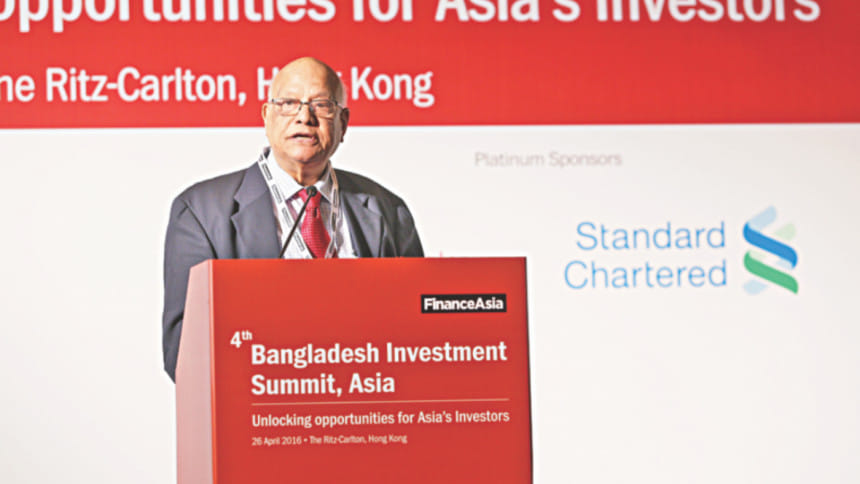Bangladesh poised to be a top investment destination

Policymakers and business leaders from Bangladesh yesterday reiterated the country’s potential as a top investment destination after China and India.
The necessary conditions for taking off the Bangladesh economy have been created, said Finance Minister AMA Muhith in his keynote speech at the fourth Bangladesh Investment Summit, Asia, held at Ritz-Carlton Hotel in Hong Kong.
“Never before, Bangladesh was so well prepared to absorb talent, technology and investment from outside. Never before the country was so investment hungry as it is today.”
The inflow of foreign direct investment into Bangladesh rose 27.19 percent year-on-year to $1.45 billion in the July-February period, according to central bank data.
“I can assure you that the environment for doing business will be even better in the coming days. We are open to you, to your ideas, innovations and enterprises.”
Over the last six years, Bangladesh consistently recorded progress on various socio-economic indicators, including GDP growth, per capita income, food production, low inflation, job creation, social mobility and women’s empowerment, he said.
The average GDP growth was at 6.4 percent, per capita national gross income rose by 9.7 percent each year, inflation rate came down to 6.1 percent at the end of March this year from almost a double-digit figure six years ago.
Foreign exchange reserves rose to $29 billion from $7.5 billion six years ago. The country used to produce only 11.1 million tonnes of food grains in 1972, but now produces 38.2 million tonnes, while arable lands declined 6 percent during the period.
“It is technology which has helped this growth, and most importantly, it is research which has consistently contributed to this growth.”
“In view of last six years' performance, we have set a goal. We want to see Bangladesh as a developed economy by 2041 -- a very ambitious target. If you look at history, it has taken much more time to reach the current status.”
But the new environment and the new versatility that is available make the country dream of becoming a developed country by 2041, he said.
Effective macroeconomic plans, along with the implementation of the sixth and seventh five-year plans, have helped Bangladesh avert the impact of the global economic downturn and sustain the economic growth over the last six years, he said.
Sustained accelerated growth is the fact over the country's development policy, which is aligning with three dimensions of sustainable development goals: promoting inclusive economic growth, protecting the environment and promoting social progress.
“We have paid the highest importance to accelerating domestic demands, and the strategy that has been followed was based on taking more people out of poverty on the one hand and exploring and exploiting the growing export markets on the other.”
Referring to Bangladesh's current status of lower middle-income country, he said when a country reaches the coveted position, it forgets about domestic demands.
“It is my view that the stagnancy you witnessed in some countries is mainly because they forget their original objectives, which is increasing the domestic demand. So, how do we increase the domestic demand by taking more people out of poverty? We are developing their capacity to earn and also to spend.”
Muhith cited the scarcity of land as a big problem for investment.
“In this land-hungry country, it is very difficult to spare lands for large investment projects. We have some export processing zones and we are now introducing a number of small economic zones for investors.”
“We do have problems now and then, but we try to resolve them through dialogue and discussions and that is I believe one of the most important components of the economy.”
The daylong event, which was sponsored by Standard Chartered Bangladesh and City Bank, highlighted the country's macroeconomic fundamentals, growth sectors, investment outlook, the associated challenges and the potential mitigants for the relevant investment.
LankaBangla Investments, DFDL and PwC were associate sponsors of the event, which was supported by the Board of Investment, Bangladesh.
The summit was organised by FinanceAsia, a leading financial journal in Asia and the Pacific, in association with AsianInvestor, a magazine focused on asset management, mutual funds, alternatives, private banking and financial services in the region.
Presenting another keynote paper on 'energy outlook for Bangladesh', Tawfiq-e-Elahi Chowdhury, the prime minister's adviser on power, energy and mineral resources, said: “Bangladesh's is an unfolding story. Join us. We will make money, you will make money and Bangladesh will make its future.”
Prior to making the appeal, he cited the robust growth in power generation over the last seven years.
During the period, $8 billion was invested in the power sector in public-private partnerships and another $13 billion are in the pipeline, he said.
The investment has resulted in access to electricity for nearly 80 percent of the population. Seven years ago, it was only 47 percent.
“But still there are unlimited opportunities of investment in the power sector, as we will need to generate some 46,000MW power by 2041 with $15 billion worth of investment.”
While inviting the foreign entrepreneurs to invest in gas- and coal-based power projects, Chowdhury said: “We need this investment so that we can supply smooth power to the industrialists and entrepreneurs.”
Replying to a query from the audience, he said the liquefied natural gas will be in place by 2017 or early 2018.
Ajay Kanwal, chief executive officer of Standard Chartered Bank for the Asean and South Asia region, in his opening remarks said Bangladesh has a very strong and resilient economy and maintaining a progressive growth since its independence.
“So, it's a lucrative investment destination,” he said, adding that the key factors that can attract foreign investors are there: stable GDP growth, steady currency and a stable government for many years.
For a foreign investor, good returns, capital safety and dividend or capital repatriation are the three major issues. “From our experience in Bangladesh as a foreign investor, we can say that all the three conditions are met.”
But there are challenges too. The country is paying too much attention to garment and textile exports. “Bangladesh needs to diversify its export and attract investment,” he added.
Hossain Khaled, president of Dhaka Chamber of Commerce and Industry, said Bangladesh is the next destination of foreign investment after China and India.
Human capital is one of the demographic advantage, as three million people join the workforce every year, he said, adding that Bangladesh can continue the supply of the workforce until 2045.
There are seven core areas where billion dollar investment opportunities are lying -- physical infrastructure, power, backward linkage industry for garment and textile, automotive, pharmaceuticals, leather and shipbuilding, he said.
Shahwar Nizam, country partner of DFDL Bangladesh, said the legal regime is very much investment friendly. Foreign investors can replicate their investment in Bangladesh, he said, while referring to dividend repatriation.
Biru Paksha Paul, chief economist of Bangladesh Bank, delivered a keynote presentation on monetary policy and Paban Chowdhury, executive chairman of Bangladesh Economic Zones Authority, spook on investments in the economic zones.
Six other panel discussions focused on Bangladesh investment today; power and energy; export potential and ICT developments; investment opportunities; capital market; and PPP.

 For all latest news, follow The Daily Star's Google News channel.
For all latest news, follow The Daily Star's Google News channel. 



Comments